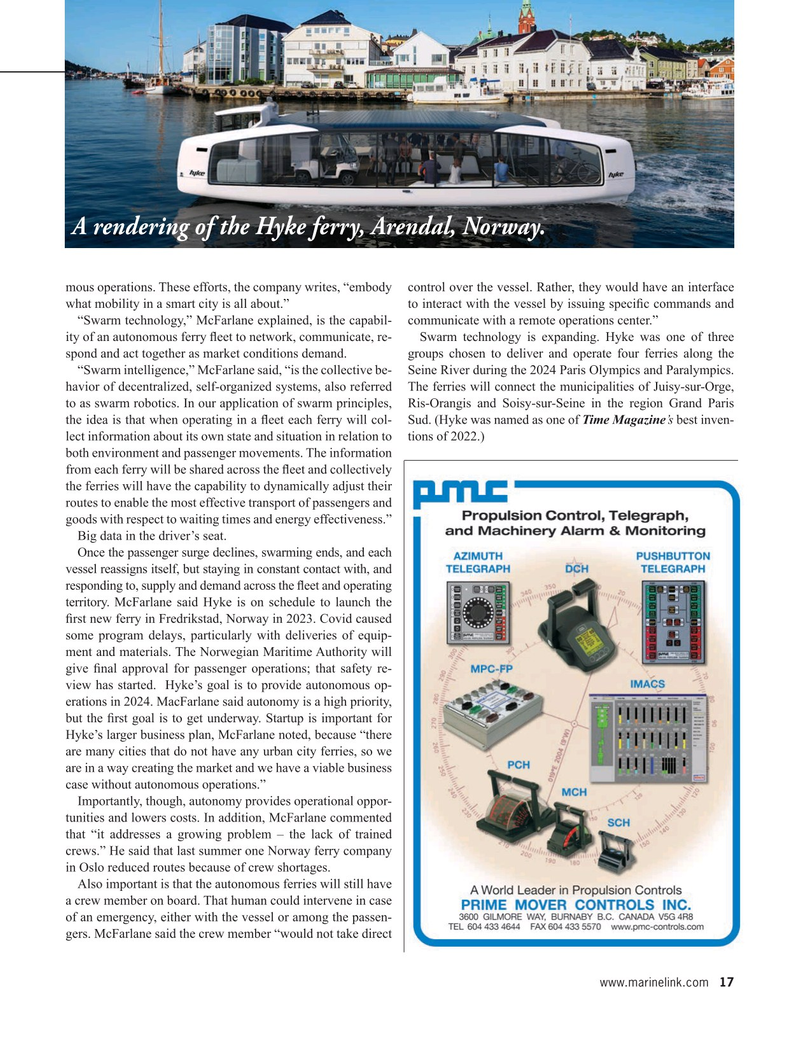
Page 17: of Maritime Reporter Magazine (February 2023)
Government Shipbuilding
Read this page in Pdf, Flash or Html5 edition of February 2023 Maritime Reporter Magazine
A rendering of the Hyke ferry, Arendal, Norway. mous operations. These efforts, the company writes, “embody control over the vessel. Rather, they would have an interface what mobility in a smart city is all about.” to interact with the vessel by issuing speci? c commands and “Swarm technology,” McFarlane explained, is the capabil- communicate with a remote operations center.” ity of an autonomous ferry ? eet to network, communicate, re- Swarm technology is expanding. Hyke was one of three spond and act together as market conditions demand. groups chosen to deliver and operate four ferries along the “Swarm intelligence,” McFarlane said, “is the collective be- Seine River during the 2024 Paris Olympics and Paralympics. havior of decentralized, self-organized systems, also referred The ferries will connect the municipalities of Juisy-sur-Orge, to as swarm robotics. In our application of swarm principles, Ris-Orangis and Soisy-sur-Seine in the region Grand Paris the idea is that when operating in a ? eet each ferry will col- Sud. (Hyke was named as one of Time Magazine’s best inven- lect information about its own state and situation in relation to tions of 2022.) both environment and passenger movements. The information from each ferry will be shared across the ? eet and collectively the ferries will have the capability to dynamically adjust their routes to enable the most effective transport of passengers and goods with respect to waiting times and energy effectiveness.”
Big data in the driver’s seat.
Once the passenger surge declines, swarming ends, and each vessel reassigns itself, but staying in constant contact with, and responding to, supply and demand across the ? eet and operating territory. McFarlane said Hyke is on schedule to launch the ? rst new ferry in Fredrikstad, Norway in 2023. Covid caused some program delays, particularly with deliveries of equip- ment and materials. The Norwegian Maritime Authority will give ? nal approval for passenger operations; that safety re- view has started. Hyke’s goal is to provide autonomous op- erations in 2024. MacFarlane said autonomy is a high priority, but the ? rst goal is to get underway. Startup is important for
Hyke’s larger business plan, McFarlane noted, because “there are many cities that do not have any urban city ferries, so we are in a way creating the market and we have a viable business case without autonomous operations.”
Importantly, though, autonomy provides operational oppor- tunities and lowers costs. In addition, McFarlane commented that “it addresses a growing problem – the lack of trained crews.” He said that last summer one Norway ferry company in Oslo reduced routes because of crew shortages.
Also important is that the autonomous ferries will still have a crew member on board. That human could intervene in case of an emergency, either with the vessel or among the passen- gers. McFarlane said the crew member “would not take direct www.marinelink.com 17
MR #2 (1-17).indd 17 2/1/2023 4:23:48 PM

 16
16

 18
18
